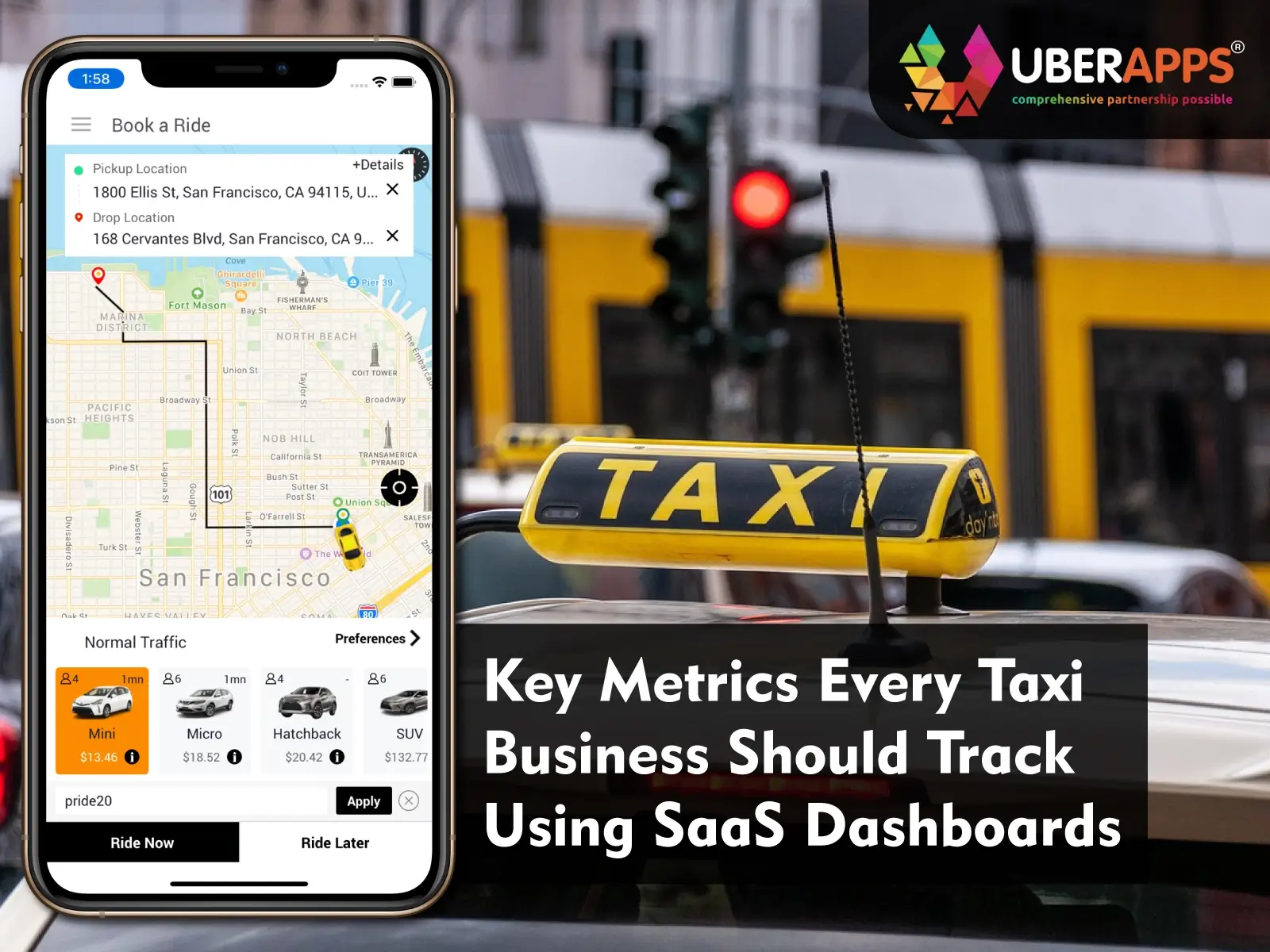
Key Metrics Every Taxi Business Should Track Using SaaS Dashboards
In today’s competitive ride-hailing industry, data is the new fuel. Taxi businesses can no longer rely on intuition alone; they must leverage data-driven strategies to stay ahead.
SaaS taxi apps with built-in dashboards help operators track key performance indicators (KPIs) across drivers, vehicles, and passengers. With this visibility, businesses can improve operational efficiency, reduce costs, and deliver a better rider experience.
By integrating ride-hailing app features, in-app payments, and AI-driven insights, SaaS dashboards have become an essential tool for modern taxi app development.
Running a successful taxi business requires more than just drivers and vehicles—it requires data-driven decision-making. With SaaS taxi apps and smart dashboards, fleet owners and operators can monitor key metrics every taxi business should track to improve efficiency, reduce costs, and boost revenue. From daily trip volumes and driver utilization rates to customer satisfaction scores and in-app payment insights, modern taxi booking apps make it easy to access and analyze real-time performance data. Instead of relying on guesswork, businesses can now use Uber clone SaaS dashboards to identify underperforming drivers, optimize routes, reduce downtime, and forecast demand with accuracy. This blog explores the most critical fleet management KPIs, the role of ride-hailing app features, and how taxi app development powered by SaaS solutions enables operators to make informed decisions. Whether you’re scaling locally or globally, tracking these metrics is key to building a sustainable, competitive taxi business.
Why Use SaaS Dashboards in Taxi App Development?
Real-Time Insights
SaaS dashboards provide live updates on trips, payments, and fleet utilization.
Scalable & Cloud-Based
Whether you manage 50 or 5,000 vehicles, SaaS solutions grow with your business.
Easy Integration
Connects seamlessly with Uber clone apps, taxi booking apps, and fleet management systems.
Key takeaway: SaaS dashboards simplify fleet management by transforming raw data into actionable insights.
Key Metrics Every Taxi Business Should Track
1 Trip Volume & Ride Requests
Monitoring total ride requests, completed trips, and cancellations is fundamental.
- Identify peak demand hours.
- Understand rider preferences.
- Optimize driver allocation.
2 Driver Utilization Rate
This metric shows how efficiently drivers are spending their time.
- Ratio of active driving hours vs. idle hours.
- Helps in designing driver incentive programs.
- Reduces downtime and increases earnings.
3 Customer Satisfaction (CSAT & Ratings)
Feedback is critical to long-term success.
- Rider ratings and complaints highlight service gaps.
- SaaS dashboards consolidate reviews in real time.
- Enables training for underperforming drivers.
4 Average Revenue Per Trip
Revenue insights help balance pricing strategies and promotions.
- Track fares vs. operational costs.
- Compare cash vs. in-app payments for taxi apps.
- Forecast profitability.
5 Fleet Maintenance & Vehicle Health
Well-maintained vehicles improve safety and reduce downtime.
- Scheduled servicing and repair logs.
- Fuel consumption and mileage reports.
- Preventive maintenance alerts via IoT integration.
Advanced Metrics Enabled by SaaS Taxi Apps
6 Heatmaps & Demand Forecasting
- AI-powered dashboards predict where rides will be requested next.
- Real-time heatmaps for driver positioning.
- Demand prediction for rush hours and events.
7 Driver Performance Scorecards
- Combines multiple KPIs into one view.
- Acceptance rate of rides.
- Trip completion time.
- Compliance with safe driving standards.
8 Customer Lifetime Value (CLV)
- CLV shows the long-term value of each passenger.
- How often riders use the app.
- Average spend per month.
- Helps design loyalty and subscription programs.
9Payment Trends
- Track cash vs. digital transactions.
- Monitor in-app payments to minimize fraud.
- Automate driver payouts.
- Financial forecasting for fleet owners.
10 Churn Rate & Retention
- Measures how many riders stop using your service.
- High churn indicates service quality issues.
- Retention strategies include loyalty points, discounts, or app improvements.
How SaaS Taxi Apps Improve Fleet Management
Centralized Dashboard for Owners
- Single platform for managing drivers, vehicles, and payments.
- Quick identification of problem areas.
AI & Automation
- Smart dispatch reduces idle time.
- Predictive maintenance lowers costs.
Multi-City Scalability
- SaaS dashboards support expansion into multiple regions.
- Customizable features for local compliance.
Key takeaway: SaaS-driven fleet management ensures scalability, cost savings, and smarter decisions.
Role of Uber Clone Apps in Tracking Metrics
Faster Deployment
Uber clone solutions include pre-built SaaS dashboards.
Proven Ride-Hailing App Features
- Driver performance tracking.
- Revenue analytics.
- Trip insights.
Flexible Customization
Clone apps can integrate public transport APIs, IoT sensors, and in-app payments for advanced analytics.
Benefits of Tracking Taxi Business Metrics
For Operators
- Improved decision-making.
- Cost savings via optimized fleet usage.
- Real-time issue resolution.
For Drivers
- Transparent earnings reports.
- Incentive-based motivation.
- Training opportunities based on performance.
For Riders
- Improved service quality.
- Faster rides with optimized dispatch.
- Better customer support.
Steps to Implement a SaaS Dashboard in Taxi App Development
- Select a SaaS taxi app provider with built-in analytics.
- Customize the dashboard with KPIs relevant to your business.
- Train drivers and staff on how to use insights.
- Integrate in-app payments for seamless financial tracking.
- Run pilot tests before full-scale rollout.
- Scale gradually and monitor improvements.
Future of Data-Driven Taxi Businesses
- AI-Powered Predictions: Smarter driver placement and route optimization.
- IoT-Enabled Fleets: Sensors tracking vehicle health in real time.
- Sustainability Metrics: Monitoring carbon footprint of trips.
- Mobility-as-a-Service (MaaS): Combining taxi booking apps with public transport for end-to-end commuting.
Key takeaway: The future of taxi app development is data-first, powered by SaaS dashboards and analytics.
Conclusion
In the modern mobility landscape, metrics define success. Without tracking performance data, taxi businesses risk inefficiency, rising costs, and poor rider experiences. Fortunately, SaaS taxi apps with smart dashboards provide operators with all the tools needed to measure, analyze, and optimize every aspect of their operations.
From trip volumes and ride-hailing app features to in-app payments for taxi apps and driver utilization, these dashboards turn complex data into simple insights. Fleet owners can reduce idle time, optimize routes, and forecast demand, while drivers benefit from transparent earnings and real-time performance feedback. Passengers, in turn, enjoy a seamless, reliable, and affordable experience.
For businesses adopting Uber clone solutions, SaaS dashboards provide an edge by offering proven frameworks, quick deployment, and future-ready scalability. As taxi app development continues to evolve, one thing is clear: tracking and acting on key metrics every taxi business should monitor is no longer optional—it is the foundation of sustainable growth.
FAQS
1. What are the key metrics every taxi business should track?
Trip volume, driver utilization, customer satisfaction, fleet maintenance, and revenue per trip are essential.
2. How do SaaS taxi apps help in tracking these metrics?
They provide real-time dashboards that consolidate trips, payments, driver performance, and customer feedback.
3. Can Uber clone apps include SaaS dashboards?
Yes, most Uber clone solutions come with analytics dashboards or can integrate them easily.
4. Why is in-app payment tracking important?
It ensures secure, transparent transactions, reduces fraud, and simplifies driver payouts.
5. What future metrics will taxi businesses need?
Sustainability metrics, EV fleet utilization, and AI-based demand forecasting will be critical.
Author's Bio

Vinay Jain is the Founder of UBERApps and brings over 10 years of entrepreneurial experience. His focus revolves around software & business development and customer satisfaction.

